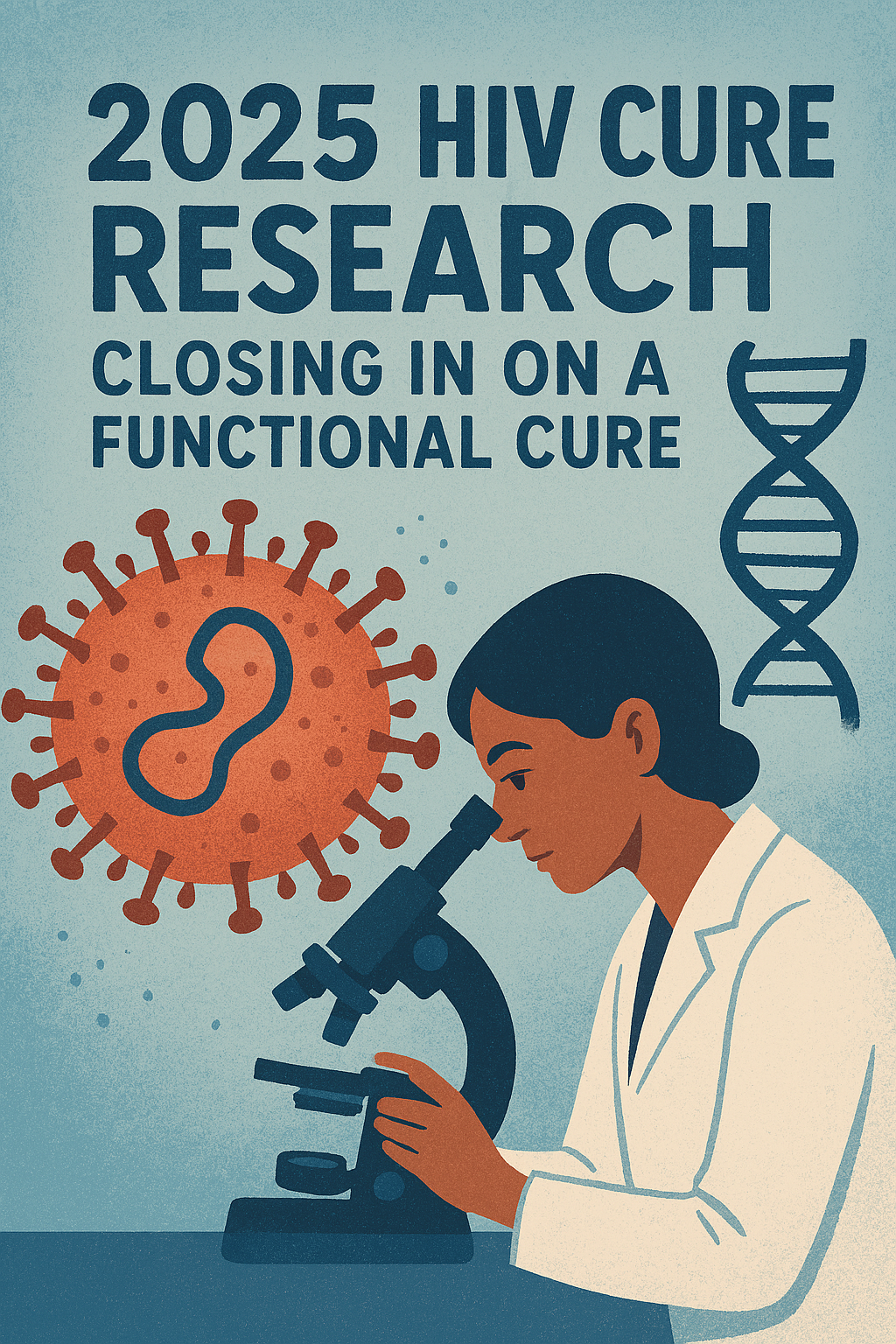In 2025, HIV cure science is entering a hopeful phase. While a sterilizing cure—complete eradication of HIV from the body—remains elusive, several promising approaches are edging us closer to a functional cure: where HIV remains under control without continuous antiretroviral therapy (ART). Recent breakthroughs across immunotherapy, gene editing, and nanomedicine suggest that long-term, drug-free HIV remission may be within reach.
What’s New: Key Advances in HIV Cure Science
- Long-Acting Therapies & Broadly Neutralizing Antibodies (bNAbs)
A clinical trial led by Rockefeller, Imperial College London, and Oxford tested two bNAbs as an alternative to daily ART. Participants remained virally suppressed for up to 20 weeks without ART—a remarkable proof that antibodies can maintain control after drug interruption.
- Immune Boosters + bNAbs in Africa
In South Africa, women from the FRESH cohort were treated with a TLR7 agonist (vesatolimod) plus two bNAbs (VRC07-523LS and CAP256V2LS). Some participants—around 20%—remained virally suppressed for nearly a year off ART. This marks the longest period of drug-free remission observed in a large trial.
- Lenacapavir: A Twice-Yearly Injection
Lenacapavir, approved in mid-2025 for prevention, is injected only twice a year yet provides near-perfect protection. Long-acting formulations like this reduce adherence challenges and set the stage for combination cure regimens.
- Targeting the Latent Reservoir
Researchers are probing how HIV “hides” in dormant cells. Studies show viral rebound depends not only on drug washout but also immune system fluctuations. New approaches aim to either “shock and kill” latent virus or “block and lock” it into permanent silence. Non-coding RNAs and circadian biology are also being studied as potential levers of control.
- Gene Editing and Immune Engineering
CRISPR/Cas9 and related tools are being refined to excise HIV DNA or modify host receptors like CCR5. Early studies show feasibility but face challenges in delivery, efficiency, and safety. Precision and scalability remain hurdles.
 Nanomedicine Immunotherapy: Prakasine’s Potential Role
Nanomedicine Immunotherapy: Prakasine’s Potential Role
In parallel with these global efforts, Prakasine nanomedicine immunotherapy, developed at Naval AIDS Research Center, represents a new frontier. Unlike conventional ART, Prakasine is designed to:
- Stimulate cytokine gene expression, enhancing innate and adaptive immune responses.
- Act as an immunomodulatory nanocarrier, delivering therapeutic payloads more efficiently to immune cells.
- Potentially complement latency-targeting strategies, either by amplifying immune clearance during “shock-and-kill” or strengthening immune surveillance in “block-and-lock” approaches.
Though still in investigational stages, Prakasine highlights how nanotechnology is being integrated into HIV cure research, offering precision delivery and multi-pathway immune activation. If ongoing studies confirm its efficacy, Prakasine could join the toolbox of advanced immunotherapies alongside bNAbs, TLR agonists, and gene editing.
Why These Advances Matter
- From suppression to remission: Instead of lifelong daily ART, patients could achieve years of remission with long-acting therapies or immune-based combinations.
- Mechanistic diversity: By targeting HIV from multiple angles—antibodies, nanomedicine, gene therapy—the likelihood of durable remission improves.
- Global relevance: Trials in Africa, especially with subtype C virus and in women, ensure that new strategies are not limited to Western contexts.
Challenges Ahead
- Durability & safety: The longest remissions achieved so far last about a year. Extending this to decades remains the goal.
- HIV reservoirs: Latent virus in hard-to-reach tissues (like the brain) makes total clearance difficult.
- Gene editing risks: Off-target mutations and delivery barriers must be solved before widespread application.
- Access & equity: Even if cures emerge, they must be affordable and deliverable in high-burden, low-resource regions.
The Road Ahead
Over the next 5–10 years, we may see functional cure regimens that combine:
- Long-acting injectables (like lenacapavir)
- Antibodies + immune stimulators (bNAbs with TLR agonists)
- Nanomedicine-based immunotherapies (like Prakasine)
- Gene editing strategies targeting viral reservoirs
Together, these approaches could transform HIV from a chronic infection requiring daily drugs into one where periodic or one-time treatments sustain lifelong control.
Conclusion
2025 is one of the most hopeful years in HIV cure research. With advances in antibody therapies, long-acting drugs, latency research, and gene editing, science is closing in on durable, drug-free remission. The addition of nanomedicine innovations like Prakasine further broadens the arsenal, bringing precision immunology into the fight.
The road to an HIV cure is not yet complete, but the convergence of these strategies suggests that what was once science fiction is becoming scientific reality. The next decade may finally deliver what millions have been waiting for: freedom from both HIV and lifelong therapy.
